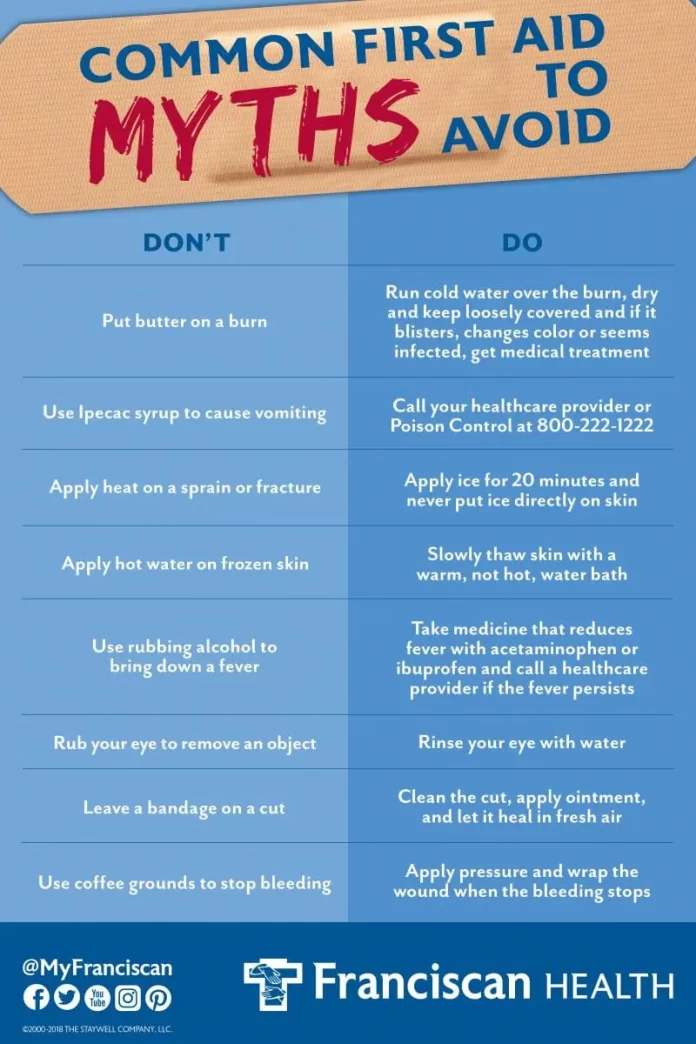First aid is a critical skill that can mean the difference between life and death in emergency situations. However, over the years, various myths and misconceptions about first aid have been perpetuated, leading people to believe in practices that may be ineffective or even harmful.
In this article, we will debunk some of the most common first aid myths and shed light on the correct approaches to handle emergencies.
Table of Contents
Myth #1: Butter or Toothpaste on Burns
One of the most prevalent misconceptions is that applying butter or toothpaste to burns can alleviate pain and promote healing. In reality, this is a harmful practice that should be avoided at all costs.
Butter and toothpaste can trap heat and bacteria, worsening the burn and increasing the risk of infection. Instead, the appropriate first aid for burns involves holding the affected area under cool running water for at least 10 minutes and then covering it with a clean, non-stick dressing.
Myth #2: Tilting the Head Back during a Nosebleed
Many people instinctively tilt their heads back when experiencing a nosebleed, believing it will prevent blood from flowing out. However, this is counterproductive as it can cause blood to flow down the throat and potentially lead to choking or aspiration.
The correct method is to lean the head slightly forward and pinch the soft part of the nose for about 10 minutes until the bleeding stops.
Myth #3: Sucking Out Venom from Snake Bites
A common misconception perpetuated in movies and folklore is the idea that sucking out venom from a snake bite can save a person’s life. In reality, attempting to suck out venom with your mouth is dangerous and ineffective.
Instead, immediately call for emergency medical assistance and keep the affected limb immobilized at or below heart level to slow the spread of venom until professional help arrives.
Myth #4: Heat for Sprains and Strains
The traditional belief of applying heat to sprains and strains is another first aid myth that can lead to worsening the injury. In the initial stages, applying heat can increase blood flow and inflammation, leading to more pain and potential complications.
Instead, the RICE (Rest, Ice, Compression, Elevation) method is the best approach for managing sprains and strains. Apply ice wrapped in a cloth for 15-20 minutes every 2-3 hours and avoid placing it directly on the skin.
Myth #5: Removing Objects from Impaled Wounds
When an object, such as a piece of glass or metal, impales the body, the instinct may be to remove it immediately. However, doing so can cause severe bleeding and damage. The object may be the only thing preventing further internal bleeding.
The correct action is to stabilize the impaled object with bulky dressings and bandages while seeking immediate medical help.
Myth #6: “Walking it off” for Head Injuries
A common misconception, particularly in sports, is the notion that athletes should “walk off” head injuries. Head injuries, such as concussions, are serious and require immediate attention. Continuing physical activity after a head injury can worsen the condition and lead to long-term consequences. Anyone suspected of having a head injury should seek medical evaluation promptly.
Myth #7: Rubbing Alcohol on Wounds
Using rubbing alcohol or hydrogen peroxide to clean wounds is an old practice, but it can damage the surrounding healthy tissue and delay wound healing. The best approach for wound care is to rinse the wound gently with clean, running water and then apply an antiseptic ointment before covering it with a sterile bandage.
Myth #8: “CPR Alone Can Restart the Heart”
While CPR (Cardiopulmonary Resuscitation) is a vital first aid technique to keep blood and oxygen flowing through the body during cardiac arrest, it does not restart the heart. CPR sustains the person until a defibrillator is available or professional medical assistance arrives to shock the heart back into a normal rhythm.
Myth #9: Butter for Eye Injuries
Another misguided belief is using butter to treat eye injuries, especially when exposed to irritants or foreign objects. This can lead to infection and further damage. The correct action is to rinse the eye thoroughly with clean water or saline solution and seek immediate medical help if the irritation persists.
Myth #10: Tourniquets for All Bleeding
Tourniquets are effective in controlling severe bleeding, but they should only be used as a last resort when direct pressure and elevation fail to control bleeding. Applying a tourniquet too tightly or for an extended period can cause severe damage to the limb. If using a tourniquet, it should be placed between the injury and the heart and loosened slightly every 15-20 minutes.
Takeaway
Now that we have debunked 10 common first aid misconceptions, it is evident that accurate knowledge is paramount when it comes to providing effective emergency care. These myths, although well-intentioned in some cases, can have severe consequences if put into practice. By arming ourselves with the right information, we can become reliable and competent first responders, ready to help those in need.
However, reading about first aid is only the first step. To truly be prepared and confident in handling emergencies, consider enrolling in a certified first aid course. These courses offer hands-on training, practical demonstrations, and expert guidance to equip you with the skills necessary to respond effectively in various emergency situations.
During a first aid course, you will learn how to assess injuries, administer CPR, manage burns, handle fractures, and much more. Moreover, you’ll gain valuable insights into the latest practices and guidelines endorsed by medical professionals. The knowledge and confidence gained from such a course can truly make a life-saving difference when it counts.
Remember, emergencies can strike at any time and anywhere, and being prepared can mean the difference between life and death. Taking the initiative to attend a first aid course not only enhances your ability to help others but also empowers you to protect yourself and your loved ones in times of crisis.
In conclusion, let’s strive to debunk misinformation surrounding first aid and embrace evidence-based practices. By staying informed and participating in first aid training, we can become valuable assets to our communities, making the world a safer place for everyone.
So, don’t wait for the unexpected to happen – take action now and become a certified first aid responder. Your knowledge and skills might just be the lifeline someone desperately needs someday.
















